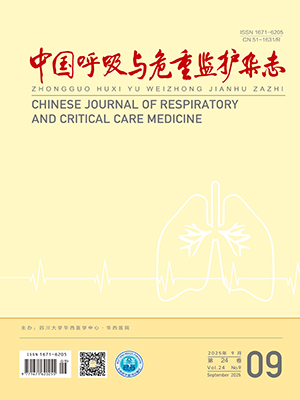| 1. |
Carbone DP, Gandara DR, Antonia SJ, et al. Non-small-cell lung cancer: role of the immune system and potential for immunotherapy. J Thorac Oncol, 2015, 10(7): 974-984.
|
| 2. |
Wang DY, Salem JE, Cohen JV, et al. Fatal toxic effects associated with immune checkpoint inhibitors: a systematic review and meta-analysis. JAMA Oncol, 2018, 4(12): 1721-1728.
|
| 3. |
Haslam A, Prasad V. Estimation of the percentage of us patients with cancer who are eligible for and respond to checkpoint inhibitor immunotherapy drugs. JAMA Netw Open, 2019, 2(5): e192535.
|
| 4. |
Friedman CF, Proverbs-Singh TA, Postow MA. Treatment of the immune-related adverse effects of immune checkpoint inhibitors: a review. JAMA Oncol, 2016, 2(10): 1346-1353.
|
| 5. |
Tirumani SH, Ramaiya NH, Keraliya A, et al. Radiographic profiling of immune-related adverse events in advanced melanoma patients treated with ipilimumab. Cancer Immunol Res, 2015, 3(10): 1185-1192.
|
| 6. |
中华医学会呼吸病学分会肺癌学组. 免疫检查点抑制剂相关肺炎诊治专家共识. 中华结核和呼吸杂志, 2019, 42(11): 820-825.
|
| 7. |
Chung M, Bernheim A, Mei XY, et al. CT imaging features of 2019 novel coronavirus (2019-nCoV). Radiology, 2020, 295(1): 202-207.
|
| 8. |
Johkoh T, Lee KS, Nishino M, et al. Chest CT diagnosis and clinical management of drug-related pneumonitis in patients receiving molecular targeting agents and immune checkpoint inhibitors: a position paper from the Fleischner Society. Radiology, 2021, 298(3): 550-566.
|
| 9. |
Nishino M, Sholl LM, Hodi FS, et al. Anti-PD-1-related pneumonitis during cancer immunotherapy. N Engl J Med, 2015, 373(3): 288-290.
|
| 10. |
Brahmer J, Reckamp KL, Baas P, et al. Nivolumab versus docetaxel in advanced squamous-cell non-small-cell lung cancer. N Engl J Med, 2015, 373(2): 123-135.
|
| 11. |
Nishino M, Giobbie-Hurder A, Hatabu H, et al. Incidence of programmed cell eeath 1 inhibitor-related pneumonitis in patients with advanced cancer: a systematic review and meta-analysis. JAMA Oncol, 2016, 2(12): 1607-1616.
|
| 12. |
Fukihara J, Sakamoto K, Koyama J, et al. Prognostic impact and risk factors of immune-related pneumonitis in patients with non-small-cell ung cancer who received programmed death 1 inhibitors. Clin Lung Cancer, 2019, 20(6): 442-450. e4.
|
| 13. |
Suresh K, Voong KR, Shankar B, et al. Pneumonitis in non-small cell lung cancer patients receiving immune checkpoint immunotherapy: incidence and risk factors. J Thorac Oncol, 2018, 13(12): 1930-1939.
|
| 14. |
Cho JY, Kim J, Lee JS, et al. Characteristics, incidence, and risk factors of immune checkpoint inhibitor-related pneumonitis in patients with non-small cell lung cancer. Lung Cancer, 2018, 125: 150-156.
|
| 15. |
Gomatou G, Tzilas V, Kotteas E, et al. Immune checkpoint inhibitor-related pneumonitis. Respiration, 2020, 99(11): 932-942.
|
| 16. |
Nishino M, Ramaiya NH, Awad MM, et al. PD-1 inhibitor-related pneumonitis in advanced cancer patients: radiographic patterns and clinical course. Clin Cancer Res, 2016, 22(24): 6051-6060.
|
| 17. |
Rossi SE, Erasmus JJ, McAdams HP, et al. Pulmonary drug toxicity: radiologic and pathologic manifestations. Radiographics, 2000, 20(5): 1245-1259.
|
| 18. |
Chuzi S, Tavora F, Cruz M, et al. Clinical features, diagnostic challenges, and management strategies in checkpoint inhibitor-related pneumonitis. Cancer Manag Res, 2017, 9: 207-213.
|
| 19. |
Camiciottoli G, Orlandi I, Bartolucci M, et al. Lung CT densitometry in systemic sclerosis: correlation with lung function, exercise testing, and quality of life. Chest, 2007, 131(3): 672-681.
|
| 20. |
Salaffi F, Carotti M, Bosello S, et al. Computer-aided quantification of interstitial lung disease from high resolution computed tomography images in systemic sclerosis: correlation with visual reader-based score and physiologic tests. Biomed Res Int, 2015, 2015: 834262.
|
| 21. |
Wu XP, Kim GH, Salisbury ML, et al. Computed tomographic biomarkers in idiopathic pulmonary fibrosis. The future of auantitative analysis. Am J Respir Crit Care Med, 2019, 199(1): 12-21.
|




